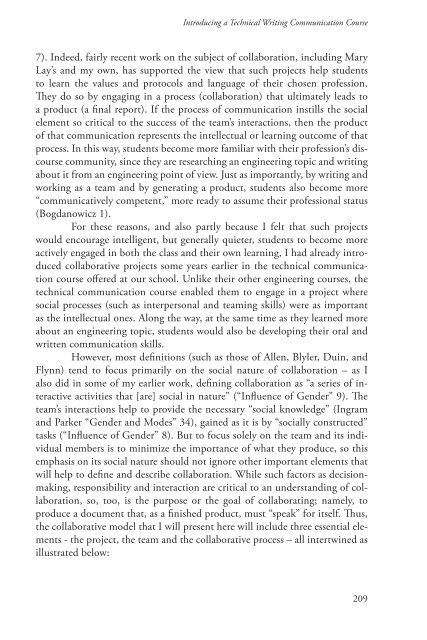Design Discourse - Composing and Revising Programs in Professional and Technical Writing, 2010a
Design Discourse - Composing and Revising Programs in Professional and Technical Writing, 2010a
Design Discourse - Composing and Revising Programs in Professional and Technical Writing, 2010a
You also want an ePaper? Increase the reach of your titles
YUMPU automatically turns print PDFs into web optimized ePapers that Google loves.
Introduc<strong>in</strong>g a <strong>Technical</strong> Writ<strong>in</strong>g Communication Course<br />
7). Indeed, fairly recent work on the subject of collaboration, <strong>in</strong>clud<strong>in</strong>g Mary<br />
Lay’s <strong>and</strong> my own, has supported the view that such projects help students<br />
to learn the values <strong>and</strong> protocols <strong>and</strong> language of their chosen profession.<br />
They do so by engag<strong>in</strong>g <strong>in</strong> a process (collaboration) that ultimately leads to<br />
a product (a f<strong>in</strong>al report). If the process of communication <strong>in</strong>stills the social<br />
element so critical to the success of the team’s <strong>in</strong>teractions, then the product<br />
of that communication represents the <strong>in</strong>tellectual or learn<strong>in</strong>g outcome of that<br />
process. In this way, students become more familiar with their profession’s discourse<br />
community, s<strong>in</strong>ce they are research<strong>in</strong>g an eng<strong>in</strong>eer<strong>in</strong>g topic <strong>and</strong> writ<strong>in</strong>g<br />
about it from an eng<strong>in</strong>eer<strong>in</strong>g po<strong>in</strong>t of view. Just as importantly, by writ<strong>in</strong>g <strong>and</strong><br />
work<strong>in</strong>g as a team <strong>and</strong> by generat<strong>in</strong>g a product, students also become more<br />
“communicatively competent,” more ready to assume their professional status<br />
(Bogdanowicz 1).<br />
For these reasons, <strong>and</strong> also partly because I felt that such projects<br />
would encourage <strong>in</strong>telligent, but generally quieter, students to become more<br />
actively engaged <strong>in</strong> both the class <strong>and</strong> their own learn<strong>in</strong>g, I had already <strong>in</strong>troduced<br />
collaborative projects some years earlier <strong>in</strong> the technical communication<br />
course offered at our school. Unlike their other eng<strong>in</strong>eer<strong>in</strong>g courses, the<br />
technical communication course enabled them to engage <strong>in</strong> a project where<br />
social processes (such as <strong>in</strong>terpersonal <strong>and</strong> team<strong>in</strong>g skills) were as important<br />
as the <strong>in</strong>tellectual ones. Along the way, at the same time as they learned more<br />
about an eng<strong>in</strong>eer<strong>in</strong>g topic, students would also be develop<strong>in</strong>g their oral <strong>and</strong><br />
written communication skills.<br />
However, most def<strong>in</strong>itions (such as those of Allen, Blyler, Du<strong>in</strong>, <strong>and</strong><br />
Flynn) tend to focus primarily on the social nature of collaboration – as I<br />
also did <strong>in</strong> some of my earlier work, def<strong>in</strong><strong>in</strong>g collaboration as “a series of <strong>in</strong>teractive<br />
activities that [are] social <strong>in</strong> nature” (“Influence of Gender” 9). The<br />
team’s <strong>in</strong>teractions help to provide the necessary “social knowledge” (Ingram<br />
<strong>and</strong> Parker “Gender <strong>and</strong> Modes” 34), ga<strong>in</strong>ed as it is by “socially constructed”<br />
tasks (“Influence of Gender” 8). But to focus solely on the team <strong>and</strong> its <strong>in</strong>dividual<br />
members is to m<strong>in</strong>imize the importance of what they produce, so this<br />
emphasis on its social nature should not ignore other important elements that<br />
will help to def<strong>in</strong>e <strong>and</strong> describe collaboration. While such factors as decisionmak<strong>in</strong>g,<br />
responsibility <strong>and</strong> <strong>in</strong>teraction are critical to an underst<strong>and</strong><strong>in</strong>g of collaboration,<br />
so, too, is the purpose or the goal of collaborat<strong>in</strong>g; namely, to<br />
produce a document that, as a f<strong>in</strong>ished product, must “speak” for itself. Thus,<br />
the collaborative model that I will present here will <strong>in</strong>clude three essential elements<br />
- the project, the team <strong>and</strong> the collaborative process – all <strong>in</strong>tertw<strong>in</strong>ed as<br />
illustrated below:<br />
209


















